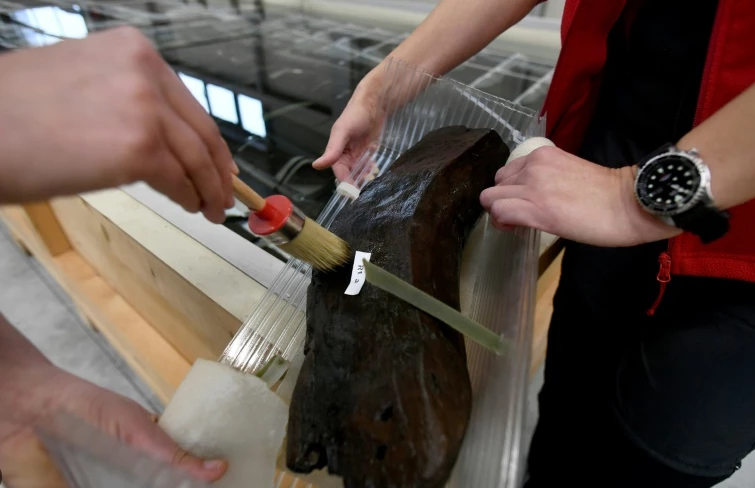Hand-sewn 3,000-year boat saved from oblivion in Croatia

Stay tuned with 24 News HD Android App

The oldest entirely hand-sewn boat in the Mediterranean is preparing for its next journey, after having sat undisturbed on Croatia's Adriatic seafloor for millennia.
But this time the vessel -- whose planks were actually sewn together -- will travel by land to France for conservation.
Discovered in the waters of Croatia's northwestern Istria peninsula, the Zambratija boat dates back to the period between late 12th and late 10th century BC: the transition period from the Bronze to the Iron Age, analyses showed.
That makes her the oldest entirely sewn boat found in the Mediterranean so far, experts said.
"She is the prototype of all 64 sewn boats discovered in the Mediterranean," said underwater archeologist Ida Koncani Uhac of the Archaeological Museum of Istria who led the research.
It is a rare example of the ancient shipbuilding tradition of Istria and Dalmatia, said experts from France's CNRS, which is collaborating with the Croatian team on the project.
It was a local fisherman who alerted archaeologists to the remains of the wooden boat, scientists locating the site in 2008.
The wreck -- of which one frame and five planks were partly visible -- was only about 150 metres (492 feet) from the shore, 2.5-metres down, covered with seaweeds and sand.
The anoxic properties of the sea mud protected it from oxygen, which would have allowed harmful bacteria to develop that would have destroyed the wood, say experts.
"It was known for decades that the boat was there, but we didn't know it was that old," Sasa Radin from the nearby village of Zambratija told AFP. "We went diving there as children."
The village, which sits off the bay where the boat was discovered, gave the vessel its name.
- Built for speed -
Originally around 10 metres long, only a third of the vessel remains.
At first, scientists first thought it was a Roman-era boat made with an ancient technique in which planks are sewn together with tendons, wood roots or vegetal fibres. A few other such boats have already been found in the Adriatic.
But to their surprise, analyses of the wood samples using radiocarbon dating carried out in Croatia, the US and France, all dated her much further back, said Koncani Uhac.
That discovery prompted years of research that brought in experts from the Camille Julianne Centre (CCJ) archaeology and ancient history reasearch laboratory in Aix-en-Provence, southern France.
Zambratija is thought to have been a mastless boat built for seven to nine rowers.
It is thought to have been used by the Histri, a local tribe after whom Istria was named.
"According to boat lines we can assume that she was a rowboat for fast navigation along the coast or through river straits on the northern Adriatic," said Koncani Uhac.
In later centuries, the Histri may have used such a boat for piracy in the northern Adriatic, intercepting Roman vessels carrying grain to supply their troops, the archaeologists said.
The boat was sewn with vegetal fibres ropes, traces of which remain visible on the wood.
According to Roman-era historians the Histri used an evergreen shrub -- the Spanish broom (Spartium junceum) -- to sew their boats.
- A technological feat -
Before the scientists eventually decided to take it out of the water, a delicate operation that took place last July, the wreck was protected with a metal construction.
The Zambratija was eventually recovered in 15 separate fragments, which were transported to a museum hangar. There, they were cleaned, analysed and tagged before being put in a specially constructed pool to desalinate.
Restorer Monika Petrovic jokingly refers to the historic find as "our wooden planks". At first, the water was changed every two or three weeks, now once a month, she told AFP.
"We are measuring the water salinity and within some two months Zambratija will be ready for the next conservation phase in Grenoble" France, she added.
The fragile remains will be transported to a pool in the Arc-Nucleart research laboratory, which specialises in the conservation and restoration of ancient archaeological objects.
Once that work is done the Zambratija should be able make a final journey home home, where it will be put on display.
The boat bears witness to a remarkable technological achievement of Istria's ancient inhabitants, said Koncani Uhac.
"First, to have a boat, a vessel, in that period, was certainly a prestige for a tribal community.
"Futhermore, to build such a boat, if we look back from our perspective to the period 3,200 years ago, it's a technological achievement in the rank of a spaceship today."
